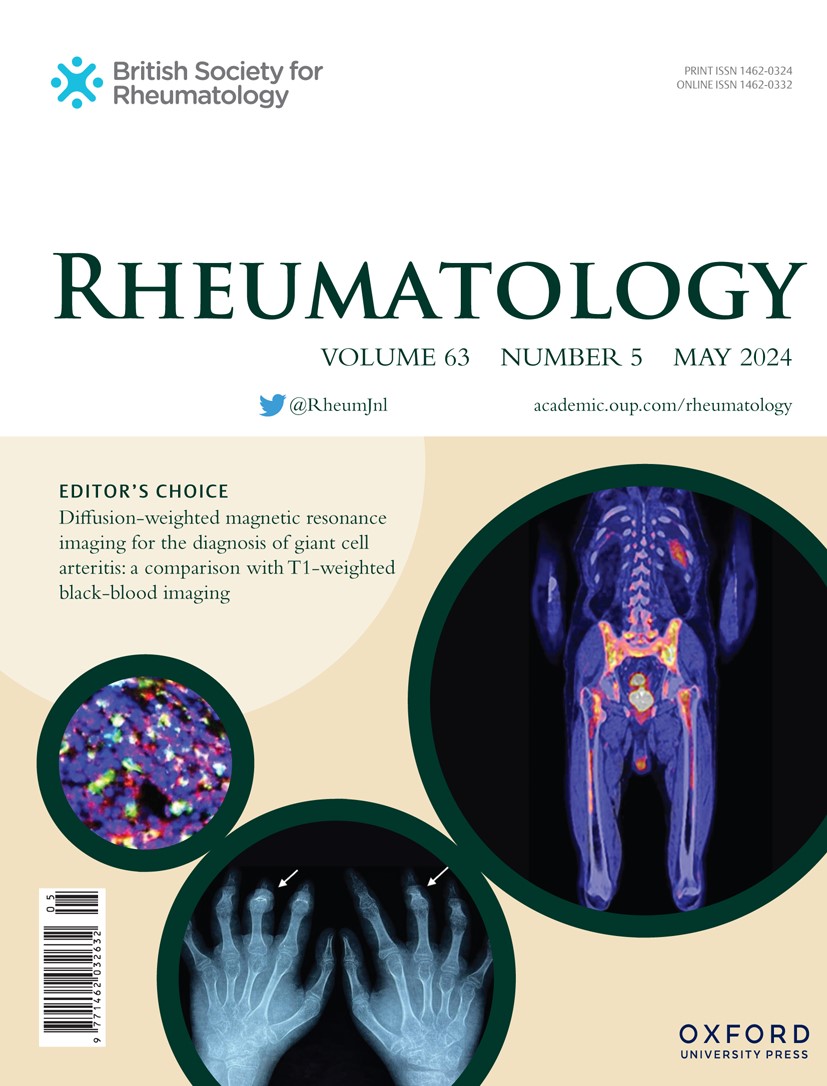P095 Reciprocal relationship of skeletal muscle function and peripheral blood lymphocytes in juvenile idiopathic arthritis: an observational pilot study
IF 4.7
2区 医学
Q1 RHEUMATOLOGY
引用次数: 0
Abstract
Background/Aims Chronic inflammation in ageing is associated with loss of skeletal muscle mass and function, known as sarcopenia. Sarcopenia is associated with multimorbidity. Juvenile idiopathic arthritis (JIA) is a chronic inflammatory disease that presents before age sixteen that carries enhanced risk of sarcopenia. The SARC-F survey is a validated screening tool for sarcopenia. The aim of this was to investigate the utility of SARC-F in identifying sarcopenia in JIA and to explore the relationship between musculoskeletal (MSK) function and peripheral lymphocyte profile in young adults with JIA. Methods Participants with JIA completed the SARC-F survey and self-reported exercise habits through online questionnaires. Peripheral blood samples were collected, and peripheral blood mononuclear cells (PBMCs) were isolated. SARC-F scores were used as a measure of MSK function to identify two groups: MSK function impaired (MFI); and MSK function not impaired (MFNI). Participants were also subdivided based on self-reported frequency of moderate exercise. PBMCs were stained and T, B and NK cell subsets were immunophenotyped using flow cytometry. Frequencies of subsets were compared between the MFI and MFNI groups and based on moderate exercise activity. Statistical analyses were performed using the Mann-Whitney U test with significant values considered as p < 0.05. Results Of the 18 participants in total, five belonged to the MFI group and 13 to the MFNI group. Median age was 24 years in both groups; 80.00% and 38.46% were female in the MFI group and MFNI groups, respectively. The MFI group had fewer CD45RA+CD27+ naïve CD4+ T cells (26.60% v. 45.30%, p = 0.0264) and greater CD45RA-CD27- effector memory CD4+ T cells (11.90% v. 7.00%, p = 0.0350). There were no differences between the CD8+ T cells phenotypes. The MFI group also had fewer CD56-CD16+ NK cells compared to the MFNI group (2.60% v. 4.28%, p = 0.0194). 13 participants reported moderate exercise activity, and five others did not. The moderate exercise group had increased total CD4+ T cells (54.06% v. 37.30%, p = 0.0140), however showed no differences between CD4+ T cell subpopulations. There was no difference in the total CD8+ T cells. However, the moderate exercise group had 3-fold fewer CD45RA+CD27- EMRA CD8+ T cells (3.17% v. 10.40%, p = 0.0350). There were no significant differences between the frequencies of B cell subpopulations. Conclusion A significant limitation of the study is the confounding effect of drug treatments on peripheral lymphocytes. Allowing for this, the study findings, such as 3-fold lower frequency of CD8+ TEMRA T cells, suggest a potential reciprocal relationship between MSK function on the peripheral immune profile suggestive of immunosenescence in JIA with impaired muscle function. Moreover, SARC-F has the potential to screen for sarcopenia in JIA. The complex relationship between skeletal muscle function, sarcopenia and the immune system in JIA warrants further investigation. Disclosure Z.D. Ladan: None. A. Ahmad: None. S. Oruganti: None. S. Sayegh: Grants/research support; SS received funding support for this work from the MRC grant. N. Zhang: None. C. Hadjicharalambous: None. J. Glanville: None. M. Castelino: None. C. Fisher: None. M. Leandro: None. A. Akbar: None. V.R. Reddy: Grants/research support; VR received funding support for this work from MRC-CARP Fellowship, Versus Arthritis, and the Division of Medicine Fellowship. D. Sen: Grants/research support; DS received funding support for this work from the MRC grant.青少年特发性关节炎骨骼肌功能与外周血淋巴细胞的相互关系:一项观察性初步研究
背景/目的衰老过程中的慢性炎症与骨骼肌质量和功能的丧失有关,称为肌肉减少症。肌肉减少症与多病有关。青少年特发性关节炎(JIA)是一种慢性炎症性疾病,出现于16岁之前,伴有肌肉减少的风险增加。SARC-F调查是一种有效的肌肉减少症筛查工具。这项研究的目的是研究SARC-F在鉴别JIA患者肌肉减少症中的作用,并探讨年轻JIA患者肌肉骨骼(MSK)功能与外周血淋巴细胞谱之间的关系。方法JIA患者完成SARC-F调查,并通过在线问卷自报运动习惯。采集外周血标本,分离外周血单个核细胞(pbmc)。使用SARC-F评分作为MSK功能的衡量标准来识别两组:MSK功能受损(MFI);MSK功能未受损(MFNI)。参与者还根据自我报告的适度运动频率进行细分。用流式细胞术对PBMCs进行染色,并对T、B和NK细胞亚群进行免疫分型。比较MFI组和MFNI组之间的亚群频率,并以适度运动活动为基础。采用Mann-Whitney U检验进行统计分析,显著值为p &;lt;0.05. 结果18例患者中,MFI组5例,MFNI组13例。两组患者的中位年龄均为24岁;MFI组女性占80.00%,MFNI组女性占38.46%。MFI组CD45RA+CD27+ naïve CD4+ T细胞较少(26.60% vs . 45.30%, p = 0.0264), CD45RA-CD27-效应记忆CD4+ T细胞较多(11.90% vs . 7.00%, p = 0.0350)。CD8+ T细胞表型间无差异。与MFNI组相比,MFI组的CD56-CD16+ NK细胞也较少(2.60% vs 4.28%, p = 0.0194)。13名参与者报告了适度的运动,另外5人没有。适度运动组CD4+ T细胞总数增加(54.06% vs . 37.30%, p = 0.0140),但CD4+ T细胞亚群之间无差异。两组间CD8+ T细胞总数无差异。然而,适度运动组的CD45RA+CD27- EMRA CD8+ T细胞减少了3倍(3.17% vs 10.40%, p = 0.0350)。B细胞亚群的频率之间没有显著差异。结论本研究的一个重要局限性是药物治疗对外周血淋巴细胞的混杂效应。考虑到这一点,研究结果,如CD8+ TEMRA T细胞频率降低3倍,表明MSK功能与外周免疫谱之间存在潜在的互反关系,提示JIA伴肌肉功能受损的免疫衰老。此外,SARC-F具有筛查JIA患者肌肉减少症的潜力。JIA骨骼肌功能、肌肉减少症和免疫系统之间的复杂关系值得进一步研究。z。d。拉丹:没有。A.艾哈迈德:没有。S. Oruganti:没有。S. Sayegh:资助/研究支持;SS从MRC获得了这项工作的资金支持。张:没有。C. Hadjicharalambous:没有。格兰维尔:没有。Castelino:没有。C. Fisher:没有。莱安德罗:没有。A.阿克巴:没有。V.R. Reddy:资助/研究支持;VR获得了MRC-CARP奖学金、抗关节炎和医学部奖学金的资金支持。D. Sen:资助/研究支持;DS从MRC获得了这项工作的资助。
本文章由计算机程序翻译,如有差异,请以英文原文为准。
求助全文
约1分钟内获得全文
求助全文
来源期刊

Rheumatology
医学-风湿病学
CiteScore
9.40
自引率
7.30%
发文量
1091
审稿时长
2 months
期刊介绍:
Rheumatology strives to support research and discovery by publishing the highest quality original scientific papers with a focus on basic, clinical and translational research. The journal’s subject areas cover a wide range of paediatric and adult rheumatological conditions from an international perspective. It is an official journal of the British Society for Rheumatology, published by Oxford University Press.
Rheumatology publishes original articles, reviews, editorials, guidelines, concise reports, meta-analyses, original case reports, clinical vignettes, letters and matters arising from published material. The journal takes pride in serving the global rheumatology community, with a focus on high societal impact in the form of podcasts, videos and extended social media presence, and utilizing metrics such as Altmetric. Keep up to date by following the journal on Twitter @RheumJnl.
 求助内容:
求助内容: 应助结果提醒方式:
应助结果提醒方式:


